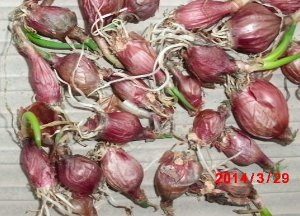
WHAT IS A BULB?
The word “bulb” is loosely used to describe plants growing from an underground mass of food storage tissues. Bulbs store enough food to enable the plants to grow and flower without added nutrients during the first year. The storage tissue is like the bulb’s lunch box, packed with enough food for the whole growing season!
A bulb is a modified stem containing a complete miniature plant, including embryonic leaf, stem, and flower parts, and surrounded by fleshy scales that provide food for the young plant and a basal plate that produces roots. A thin protective layer called a tunic surrounds the bulb.
Tulips, daffodils, and onions are true bulbs. If you slice a bulb in half horizontally, you’ll see rings formed by the scales, and if you look at one close to planting time, you’ll see a small plant in the center. An onion left in storage for too long makes a great example.
Some other plants we call bulbs, such as crocus, iris, and dahlias aren’t true bulbs because they have different botanical structures than those listed above. Crocus and gladiolus are corms. A corm stores most of its food in an enlarged basal plate rather than in its scales. Tubers, like dahlias and tuberous begonias, sprout new stems and roots from “eyes” on their surface. Rhizomes, such as iris, calla lilies, and cannas are horizontal stems capable of producing shoots and roots.
The distinction between these storage organs is very important and provides information for scientific classification and offers clues about the origin and evolution of plants. Most gardeners lump them all together as bulbs.
Bulbs are divided into two categories based on when they bloom. Spring-flowering bulbs, such as daffodils and tulips, are planted in the fall. They are called hardy bulbs because they survive cold winter conditions. They need exposure to cold temperatures in order to flower properly. Summer-flowering bulbs, including dahlias, begonias and gladiolus, are planted in the spring. They are tender and don’t survive cold winter conditions.
Spring-Flowering or Hardy Bulbs. Hardy bulbs need to be in the ground before it freezes. Bulbs develop their roots soon after planting, and lie dormant during most of the winter. When the weather warms, they draw on that “lunch box” of stored energy to produce leaves and stems, and then flowers. Some bulbs require fewer cold hours and less warming to bloom and their flowers emerge in early spring. Tulips need a longer cooling period and warmer temperatures to emerge.
Some regions are too warm to successfully grow hardy bulbs. Paper white narcissus is a good choice for warmer climates because most do not require a long cold treatment.
Bulbs take in nutrients and produce new food through photosynthesis. They store food not used for daily living in their storage organs for next year’s growth. It’s important not to cut back the leaves as soon as the bloom is spent. Once there’s enough energy in the “lunch box,” bulb leaves turn brown and die, and the bulb enters a dormant state through the summer, fall, and winter months.
Summer-Flowering or Tender Bulbs do not survive extremely cold winters and are planted after the last hard frost has passed. There are summer-flowering lilies that are hardy enough to survive winters in some areas. In northern climates, you must dig up tender bulbs and store them in a dark place that stays cool enough to keep them from sprouting prematurely.
When pollinated, most bulb flowers will produce seeds, and you can use them to grow new plants. It takes at least 5 years, and sometimes longer, for seedlings to mature and produce flowers. Many bulbs also reproduce via bulblets or offsets, tiny bulblets that form on the “mother” bulb. These baby bulbs grow over time, and once they have stored enough energy you can separate them from the mother bulb to grow new plants. These mature more quickly than seedlings. For rhizomes and tubers you propagate new plants by division.
Forcing bulbs is the process of exposing bulbs to necessary cold temperatures in a refrigerator and then planting them in an environment that makes them think it is time to grow.
